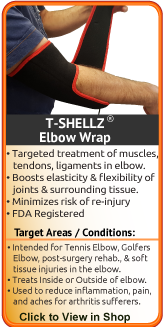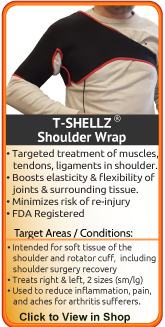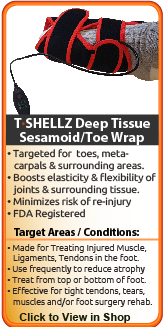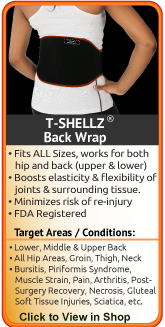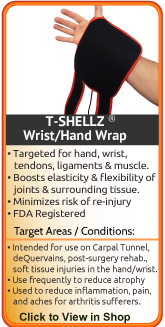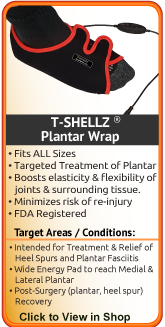Infrapatellar Bursitis Home Remedies
What You Need To Know
We Have Advanced Treatment Tools to Help You
Get Rid of Your Bursitis
The most important factor in healing infrapatellar bursitis is resting your knee. This can be difficult when you have to carry on with daily activities, but resting whenever you can is recommended. During your recovery you will probably have to modify or avoid the activities that stress your bursa until your pain and inflammation settle.
The good news is that most cases of infrapatellar bursitis will heal with simple home conservative treatments and surgery is often not needed
It's generally understood by doctors and surgeons that surgery will introduce more scar tissue into the tendons and ligaments in your knee. This added scar tissue will be problematic, requiring visits to the physio clinic and conservative treatment options post-surgery. When it comes to infrapatellar bursitis there's only a few surgical options for treatment - removal of the bursa sac, scraping of the bone(s) to allow more room for the new bursa to grow back. This is why surgery is only performed as a last resort for chronic knee bursitis that won't heal with conservative treatment methods.
Relieving the pain of your sore knee and the symptoms of bursitis initially focuses on keeping the pressure off the bursa. If your infrapatellar bursitis was caused due to the nature of your work, you really need to stop that type of work until the bursitis is gone. For non-infectious bursitis, the preliminary treatment will almost always start with conservative treatment options.
Some conservative treatment methods recommended include:
- Rest - This is important for initial recovery; rest and elevation will help reduce pain, swelling and inflammation in the early stages of injury. This can be difficult when you have to carry on with daily activities, but resting and elevating your knee whenever you can is recommended. During your recovery you will probably have to modify or avoid the activities that put stress on your knee until your pain and inflammation settles. However, too much rest can also be harmful, as knee and ankle immobility can actually cause stiffening in the joints. This is why rest should be used when reducing initial pain and swelling, but should not be considered for more long-term conservative treatment.
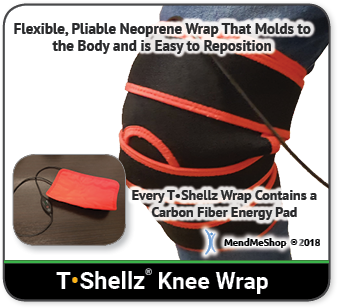 - Avoid Activities that Caused Your Knee Injury - While resting your injury it's also important to avoid all activities that may have caused your knee damage (especially any strenuous or repetitive movement). Continuing on with regular activities can increase the severity of your injury, turning a mild to moderate case of tissue damage into a downward spiral that can often severely impact your life. Also, trying to 'work around' your injury will eventually give rise to over-compensation injuries in other areas of your body.
- Use a Cold Compress or Ice Pack - Cold is very effective at reducing pain and inflammation - use at the onset of the injury and during flareups.
- Use a Knee TShellz Wrap® - Once swelling has been reduced, you can use your own blood flow to maximize your rehabilitation. Improved blood flow to your knee in most cases will help improve recovery time while improving overall health of soft tissue in the area. Knowing the body uses blood flow to heal soft tissue, this wrap is intended to maximize your rehabilitation by maintaining a healthy blood flow to soft tissue. Increased blood flow to damaged soft tissue should augment the bodys' own repair process, helping decrease recovery time while reducing re-injury risk. Promoting blood flow and heat to the treatment area will help to minimize the growth of scar tissue, increase tissue flexibility and help reduce onset of atrophy. This is why we recommend a TShellz Wrap treatment before undergoing activity - an increase in flexibility should help reduce risk of further injury while also assisting in the battle against atrophy. Heat via the TShellz Wrap® is especially helpful in dealing with chronic tendon & muscle injuries or on-going pain and stiffness from a strained knee.
- Use a Knee Support & Compression Sleeve - If you are experiencing discomfort or a feeling of knee instability, the MendMeShop Knee Sleeve is designed to help. The compression sleeve will move easily with your body with no stiffness in the sleeve itself despite being compression apparel. The sleeve is designed not to chafe the skin and reduce stiffness, swelling, and inflammation in the joint.
- For reducing discomfort while resting, (or to get some sleep) consider a High Quality Back Pillow and/or Knee Pillow for comfort while sleeping or sitting
- Try to Avoid Over Compensating for your Injury on your "'Healthy' (Non-Injured) Side - Many people will start limping or carrying objects with their opposite arm to compensate for their leg injury. Our bodies can adapt easily to any changes, including a hamstring injury. This quick adaptation could mean that you are already compensating for your injury without even knowing it!
When you compensate for your injury by using your opposite ('healthy') arm, leg, shoulder, knee, foot, etc. - then you are putting more weight and pressure on that side of your body. In many cases, your dominant side was injured (if you're right-handed this would be your right side) so your weaker side is trying to pick up the slack! The pain, stiffness, swelling and inflammation you then get on your 'healthy' side is something referred to as 'over-compensation pain'. Over-compensating for your injury can lead to other injuries and as such, it is important to be aware of how you are compensating so you can be extra careful; if there is an overcompensation flareup, treat this with the same conservative treatment methods to keep in under control.
- Rehabilitative Stretching under supervision of a PT or doctor. The intent of this is to provide you with increased range of motion, pain relief and strengthening of the surrounding tissue of the joint. Doctors or surgeons typically won't perform a surgery until they feel that their patient has put effort into treating their injury with conservative treatment methods. This may include up to 4 to 6 months of visits to a PT clinic. If you haven't experienced any improvement in your condition during that time then surgery may be considered. Agressive PT approaches may focus on forced or manual manipulation of the leg/knee - this means your physical therapists will be trying to move your knee past the point of comfort as they strive to increase range of motion and prevent further atrophy. This can be painful and end up making your injury worse if not done correctly. (reference: 1)
- Stretching - Stretching your joint in PT and at home will help you to regain your range of motion much faster than not stretching at all. Stretching in many ways is key maintaining good Range of Motion (ROM) in your joint, and stretching can be made much easier with use of a TShellz Wrap® before to warm up soft tissue, and a Cold Compress or Ice Pack treatment after to prevent any return of swelling and inflammation.
| 